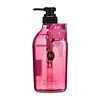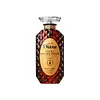What's inside
What's inside
 Key Ingredients
Key Ingredients

 Benefits
Benefits

 Concerns
Concerns

 Ingredients Side-by-side
Ingredients Side-by-side

Water
Skin ConditioningSodium Laureth Sulfate
CleansingCocamidopropyl Betaine
CleansingDipropylene Glycol
HumectantSodium Glycolate
BufferingGuar Hydroxypropyltrimonium Chloride
Skin ConditioningHydroxyethyl Urea
HumectantPolyquaternium-7
Propyltrimoniumchloride Acrylamide/Dimethylacrylamide Copolymer
Lactic Acid
BufferingHoney
HumectantSodium Hyaluronate
HumectantHydrolyzed Conchiolin Protein
Skin ConditioningTea-Sulfate
BufferingLauric Acid
CleansingCitric Acid
BufferingSalicylic Acid
MaskingDisodium EDTA
Ammonium Lactate
BufferingButylene Glycol
HumectantPhenoxyethanol
PreservativeBenzyl Benzoate
AntimicrobialParfum
MaskingWater, Sodium Laureth Sulfate, Cocamidopropyl Betaine, Dipropylene Glycol, Sodium Glycolate, Guar Hydroxypropyltrimonium Chloride, Hydroxyethyl Urea, Polyquaternium-7, Propyltrimoniumchloride Acrylamide/Dimethylacrylamide Copolymer, Lactic Acid, Honey, Sodium Hyaluronate, Hydrolyzed Conchiolin Protein, Tea-Sulfate, Lauric Acid, Citric Acid, Salicylic Acid, Disodium EDTA, Ammonium Lactate, Butylene Glycol, Phenoxyethanol, Benzyl Benzoate, Parfum
Water
Skin ConditioningSodium C14-16 Olefin Sulfonate
CleansingCocamidopropyl Betaine
CleansingCocamide Methyl Mea
Tea-Cocoyl Glutamate
CleansingSteardimonium Hydroxypropyl Hydrolyzed Keratin
Skin ConditioningPropanediol
SolventGamma-Docosalactone
Skin ConditioningQuaternium-33
Dipropylene Glycol
HumectantButylene Glycol
HumectantAlanine
MaskingHydroxyproline
Skin ConditioningHydrolyzed Honey Protein
Skin ConditioningSodium PCA
HumectantKeratin
Skin ConditioningHydrolyzed Conchiolin Protein
Skin ConditioningPrunus Domestica Seed Extract
EmollientMalus Domestica Fruit Cell Culture Extract
Skin ConditioningCollagen
MoisturisingSodium Hyaluronate
HumectantHydroxypropyltrimonium Hyaluronate
Rhododendron Ferrugineum Leaf Cell Culture Extract
Skin ConditioningCeramide AP
Skin ConditioningIsomalt
HumectantPolyquaternium-10
Hydrolyzed Keratin
HumectantHydrolyzed Hyaluronic Acid
HumectantCetearamidoethyl Diethonium Hydrolyzed Rice Protein
Isononyl Isononanoate
EmollientIsostearoyl Hydrolyzed Keratin
CleansingPouteria Sapota Seed Oil
EmollientSclerocarya Birrea Seed Oil
HumectantTheobroma Grandiflorum Seed Butter
Skin ConditioningMangifera Indica Seed Oil
EmollientGlycine Soja Sterols
EmollientCeramide Ng
Skin ConditioningArgania Spinosa Kernel Oil
EmollientCeramide Ag
HumectantCeramide NP
Skin ConditioningCeramide EOP
Skin ConditioningBis-Ethoxydiglycol Cyclohexane 1,4-Dicarboxylate
EmollientCarapa Guaianensis Seed Oil
Skin ConditioningAdansonia Digitata Seed Oil
EmollientOpuntia Ficus-Indica Seed Oil
EmollientSodium Chloride
MaskingArgania Spinosa Sprout Cell Extract
Skin ConditioningCholesterol
EmollientXanthan Gum
EmulsifyingSodium Cocoamphoacetate
CleansingSodium Methyl Cocoyl Taurate
CleansingMyristamine Oxide
CleansingPotassium Cocoyl Hydrolyzed Keratin
Skin ConditioningLecithin
EmollientQuaternium-18
Behentrimonium Chloride
PreservativePEG-7 Glyceryl Cocoate
EmulsifyingGlycerin
HumectantPropylene Glycol
HumectantCitric Acid
BufferingLactic Acid
BufferingTocopherol
AntioxidantDisodium EDTA
Sodium Benzoate
MaskingPhenoxyethanol
PreservativeParfum
MaskingCaramel
Cosmetic ColorantWater, Sodium C14-16 Olefin Sulfonate, Cocamidopropyl Betaine, Cocamide Methyl Mea, Tea-Cocoyl Glutamate, Steardimonium Hydroxypropyl Hydrolyzed Keratin, Propanediol, Gamma-Docosalactone, Quaternium-33, Dipropylene Glycol, Butylene Glycol, Alanine, Hydroxyproline, Hydrolyzed Honey Protein, Sodium PCA, Keratin, Hydrolyzed Conchiolin Protein, Prunus Domestica Seed Extract, Malus Domestica Fruit Cell Culture Extract, Collagen, Sodium Hyaluronate, Hydroxypropyltrimonium Hyaluronate, Rhododendron Ferrugineum Leaf Cell Culture Extract, Ceramide AP, Isomalt, Polyquaternium-10, Hydrolyzed Keratin, Hydrolyzed Hyaluronic Acid, Cetearamidoethyl Diethonium Hydrolyzed Rice Protein, Isononyl Isononanoate, Isostearoyl Hydrolyzed Keratin, Pouteria Sapota Seed Oil, Sclerocarya Birrea Seed Oil, Theobroma Grandiflorum Seed Butter, Mangifera Indica Seed Oil, Glycine Soja Sterols, Ceramide Ng, Argania Spinosa Kernel Oil, Ceramide Ag, Ceramide NP, Ceramide EOP, Bis-Ethoxydiglycol Cyclohexane 1,4-Dicarboxylate, Carapa Guaianensis Seed Oil, Adansonia Digitata Seed Oil, Opuntia Ficus-Indica Seed Oil, Sodium Chloride, Argania Spinosa Sprout Cell Extract, Cholesterol, Xanthan Gum, Sodium Cocoamphoacetate, Sodium Methyl Cocoyl Taurate, Myristamine Oxide, Potassium Cocoyl Hydrolyzed Keratin, Lecithin, Quaternium-18, Behentrimonium Chloride, PEG-7 Glyceryl Cocoate, Glycerin, Propylene Glycol, Citric Acid, Lactic Acid, Tocopherol, Disodium EDTA, Sodium Benzoate, Phenoxyethanol, Parfum, Caramel
Ingredients Explained
These ingredients are found in both products.
Ingredients higher up in an ingredient list are typically present in a larger amount.
Butylene Glycol (or BG) is used within cosmetic products for a few different reasons:
Overall, Butylene Glycol is a safe and well-rounded ingredient that works well with other ingredients.
Though this ingredient works well with most skin types, some people with sensitive skin may experience a reaction such as allergic rashes, closed comedones, or itchiness.
Learn more about Butylene GlycolCitric Acid is an alpha hydroxy acid (AHA) naturally found in citrus fruits like oranges, lemons, and limes.
Like other AHAs, citric acid can exfoliate skin by breaking down the bonds that hold dead skin cells together. This helps reveal smoother and brighter skin underneath.
However, this exfoliating effect only happens at high concentrations (20%) which can be hard to find in cosmetic products.
Due to this, citric acid is usually included in small amounts as a pH adjuster. This helps keep products slightly more acidic and compatible with skin's natural pH.
In skincare formulas, citric acid can:
While it can provide some skin benefits, research shows lactic acid and glycolic acid are generally more effective and less irritating exfoliants.
Most citric acid used in skincare today is made by fermenting sugars (usually from molasses). This synthetic version is identical to the natural citrus form but easier to stabilize and use in formulations.
Read more about some other popular AHA's here:
Learn more about Citric AcidCocamidopropyl Betaine is a fatty acid created by mixing similar compounds in coconut oil and dimethylaminopropylamine, a compound with two amino groups.
This ingredient is a surfactant and cleanser. It helps gather the dirt, pollutants, and other impurities in your skin to be washed away. It also helps thicken a product and make the texture more creamy.
Being created from coconut oil means Cocamidopropyl Betaine is hydrating for the skin.
While Cocamidopropyl Betaine was believed to be an allergen, a study from 2012 disproved this. It found two compounds in unpure Cocamidopropyl Betaine to be the irritants: aminoamide and 3-dimethylaminopropylamine. High-grade and pure Cocamidopropyl Betaine did not induce allergic reactions during this study.
Learn more about Cocamidopropyl BetaineDipropylene Glycol is a synthetically created humectant, stabilizer, and solvent.
This ingredient helps:
Dipropylene glycol is technically an alcohol, but it belongs to the glycol family (often considered part of the ‘good’ alcohols). This means it is hydrating and gentle on skin unlike drying solvent alcohols like denatured alcohol.
As a masking agent, Dipropylene Glycol can be used to cover the smell of other ingredients. However, it does not have a scent.
Studies show Dipropylene Glycol is considered safe to use in skincare.
Learn more about Dipropylene GlycolDisodium EDTA plays a role in making products more stable by aiding other preservatives.
It is a chelating agent, meaning it neutralizes metal ions that may be found in a product.
Disodium EDTA is a salt of edetic acid and is found to be safe in cosmetic ingredients.
Learn more about Disodium EDTAWe don't have a description for Hydrolyzed Conchiolin Protein yet.
Lactic Acid is another well-loved alpha hydroxy acid (AHA). It is gentler than glycolic acid but still highly effective.
Its main role is to exfoliate the surface of the skin by loosening the “glue” that holds dead skin cells together. Shedding those old cells leads to smoother, softer, and more even-toned skin.
Because lactic acid molecules are larger than glycolic acid, they don’t penetrate as deeply. This means they’re less likely to sting or irritate, making it a great choice for beginners or those with sensitive skin.
Like glycolic acid, it can:
Lactic acid also acts as a humectant (like hyaluronic acid). It can draw water into the skin to improve hydration and also plays a role in the skin's natural moisturizing factor (NMF) in the form of sodium lactate.
Studies show it can boost ceramide production to strengthen the skin barrier and even help balance the skin’s microbiome.
To get results, choose products with a pH between 3-4.
Lower strengths (5-12%) focus on surface exfoliation; higher strengths (12% and up) can reach deeper in the dermis (deeper, supportive layer) to improve skin texture and firmness over time.
Though it was originally derived from milk, most modern lactic acid used in skincare is vegan. It is made through non-dairy fermentation to create a bio-identical and stable form suitable for all formulations.
When lactic acid shows up near the end of an ingredient list, it usually means the brand added just a tiny amount to adjust the product’s pH.
Legend has it that Cleopatra used to bathe in sour milk to help reduce wrinkles.
Lactic acid is truly a gentle multitasker: it exfoliates, hydrates, strengthens, and brightens. It's a great ingredient for giving your skin a smooth, glowing, and healthy look without the harshness of stronger acids.
Read more about some other popular AHA's here:
Learn more about Lactic AcidParfum is a catch-all term for an ingredient or more that is used to give a scent to products.
Also called "fragrance", this ingredient can be a blend of hundreds of chemicals or plant oils. This means every product with "fragrance" or "parfum" in the ingredients list is a different mixture.
For instance, Habanolide is a proprietary trade name for a specific aroma chemical. When used as a fragrance ingredient in cosmetics, most aroma chemicals fall under the broad labeling category of “FRAGRANCE” or “PARFUM” according to EU and US regulations.
The term 'parfum' or 'fragrance' is not regulated in many countries. In many cases, it is up to the brand to define this term.
For instance, many brands choose to label themselves as "fragrance-free" because they are not using synthetic fragrances. However, their products may still contain ingredients such as essential oils that are considered a fragrance by INCI standards.
One example is Calendula flower extract. Calendula is an essential oil that still imparts a scent or 'fragrance'.
Depending on the blend, the ingredients in the mixture can cause allergies and sensitivities on the skin. Some ingredients that are known EU allergens include linalool and citronellol.
Parfum can also be used to mask or cover an unpleasant scent.
The bottom line is: not all fragrances/parfum/ingredients are created equally. If you are worried about fragrances, we recommend taking a closer look at an ingredient. And of course, we always recommend speaking with a professional.
Learn more about ParfumPhenoxyethanol is a preservative that has germicide, antimicrobial, and aromatic properties. Studies show that phenoxyethanol can prevent microbial growth. By itself, it has a scent that is similar to that of a rose.
It's often used in formulations along with Caprylyl Glycol to preserve the shelf life of products.
Sodium Hyaluronate is hyaluronic acid's salt form. It is commonly derived from the sodium salt of hyaluronic acid.
Like hyaluronic acid, it is great at holding water and acts as a humectant. This makes it a great skin hydrating ingredient.
Sodium Hyaluronate is naturally occurring in our bodies and is mostly found in eye fluid and joints.
These are some other common types of Hyaluronic Acid:
Learn more about Sodium HyaluronateWater. It's the most common cosmetic ingredient of all. You'll usually see it at the top of ingredient lists, meaning that it makes up the largest part of the product.
So why is it so popular? Water most often acts as a solvent - this means that it helps dissolve other ingredients into the formulation.
You'll also recognize water as that liquid we all need to stay alive. If you see this, drink a glass of water. Stay hydrated!
Learn more about Water